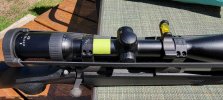Mike300wby
Well-Known Member
- Joined
- Oct 16, 2016
- Messages
- 73
Thanks for the information.
If you check the alignment on a 2 ring set up and it is off, is there some type of adjustment that can be done to correct?
If you check the alignment on a 2 ring set up and it is off, is there some type of adjustment that can be done to correct?



